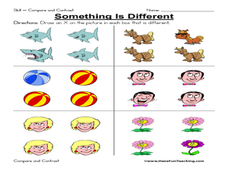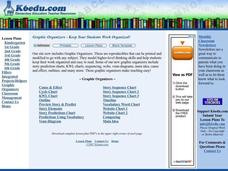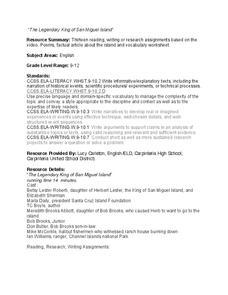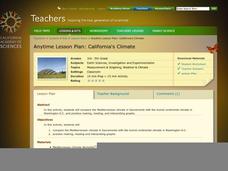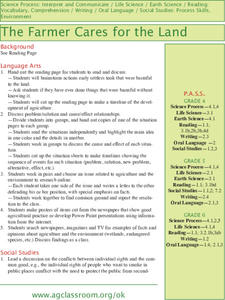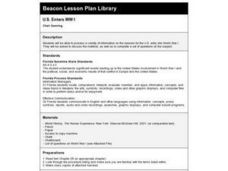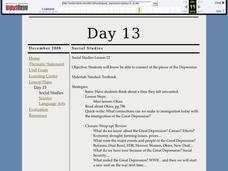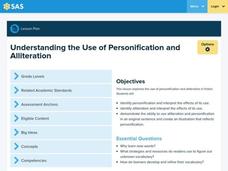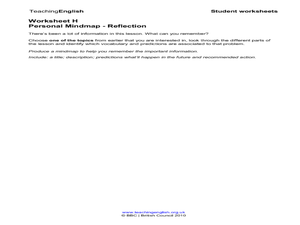Curated OER
Literature Circles
Fourth graders work in groups in order to motivate one another to develop reading comprehension and literacy skills. The skills are built through the sharing of fine literature. They maintain a reading log to keep accountable for the...
Curated OER
Journeys...The Voices of Change
Students trace the immigration patterns of their ancestors. They plot information on a world map, develop a timeline of target immigration patterns, research and write a report on immigration and participate in a class play.
Curated OER
Skip Count by 2
In this skip counting worksheet, students use a hundreds chart and skip count by 2, then complete 10 multiplication problems. A website reference for additional resources is given.
Curated OER
Figurative Language
Twelfth graders examine personification and alliteration in various reading selections. They read magazine articles, brochures, and advertisements, identify the examples of personification and alliteration, and create a business name...
Curated OER
Something is Different: Same/Different
In this different/same worksheet, student draw an X on the picture in a box that is different from the others, 6 sets total. A reference web site is given for additional activities.
Curated OER
Extra! Extra! Titanic Sinks
Students investigate the sinking of the Titanic in 1912 before writing a newspaper page that includes facts about the event. They role play as reporters, editors, and survivors of the disaster while writing and designing a front page...
Curated OER
Graphic Organizers
Students complete graphic organizers. In this graphic organizer lesson plan, students fill out various graphic organizers in order to better understand a comprehension skill. Eighteen graphic organizers are included.
Curated OER
Language Immersion
Students listen to an audio program aired on Nation Public Radio that presents a journalists report of the Blackfeet immersion programs taking place in Browning, Montana. They take notes on the program. Students discuss how immersion...
University of North Carolina
Argument
What elements make up a successful argument? A helpful resource describes aspects of an argument such as the claim, evidence, counterargument, and audience. Perfect as an individual assignment for a flipped lesson or collaborative work,...
Channel Islands Film
The Legendary King of San Miguel: Lesson Plan 3 - Grades 9-12
The documentary, The Legendary King of San Miguel Island, introduces the fascinating tale of Herb Lester, his family, and their life on San Miguel Island. Viewers have an opportunity to expand their study of the island and of...
California Academy of Science
California's Climate
The United States is a large country with many different climates. Graph and analyze temperature and rainfall data for Sacramento and Washington DC as you teach your class about the characteristics of Mediterranean climates. Discuss the...
Smarter Balanced
Communicable Diseases
Pathogens, what they are, how they spread, and how to prevent them from spreading are the focus of this resource that can be used to prepare learners for a performance task assessment or to begin the study of communicable diseases.
Chymist
The Extraction and Identification of Artificial Food Colors
Did you know some food dyes are considered safe while others are considered carcinogenic? During the experiment, young chemists extract artificial food colors from prepared foods. Then, they use chromatography paper to identify...
Curated OER
Simulation Test
Students evaluate an ecosystem and consider how it would respond to varied events. In this Earth science lesson, students work in small groups to analyze an ecosystem's response to teacher created scenarios. Student's compare their...
Curated OER
Creating Context: The Printing Press as Impetus
Tenth graders examine the invention of the Gutenberg printing press and its effect on society. In groups, they research how much the press enabled various revolutions around the globe. They also identify the causes and effects of each...
Curated OER
The Farmer Cares for the Land
Students identify cause and effect relationships in issues relating to agriculture and the environment.
Curated OER
Catherine, Called Birdy: February and March
Middle schoolers discuss characterization and relate to the main character in Catherine, Called Birdy. For this Catherine, Called Birdy lesson, students discuss passages that are comedic and sad and the effect they have on their...
Curated OER
Indian Removal
Fourth graders read The Trail of Tears and create a timeline to show the sequence of events that effected the Native American tribes during Andrew Jackson's presidency. In this Native American lesson plan, 4th graders discuss the...
Curated OER
Caring for the Land
Students study soil management and issues relating to agriculture and the environment. In this agriculture and environment instructional activity, students define the terms farmer, environmentalist, and activist. Students use a Venn...
Curated OER
By Dawn's Early Light
Fourth graders explore the history of the "Star-Spangled Banner". In the process, they explore how the lyrics of a song can be a form of poetry and the principles of cause and effect. After a class discussion, 4th graders complete a...
Curated OER
U.S. Enters World War I
Students explore the reasons why the United States entered into World War I and how that conflict effected the United States and Europe politically, economically and socially.
Curated OER
The Great Depression
Eleventh graders study the aspects of the Great Depression. In this American History activity, 11th graders will analyze the causes and effects of the Depression on American Society.
Curated OER
Review of Personification and Alliteration
Students study personification and alliteration in various fiction texts. In this literary devices lesson, students use various texts to identify the literary devices of personification and alliteration. Students use examples of both...
Curated OER
ESL: Environmental Problems
In this ESL environmental problem activity, students work with a partner to explain a set of terms, then divide a set of words that have to do with the environment into syllables.




